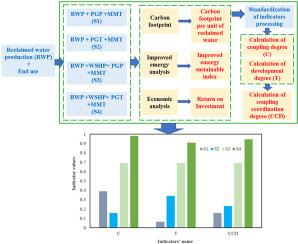通过优化终端用途,促进基于碳能经济的中水回用耦合协调
IF 10
1区 环境科学与生态学
Q1 ENGINEERING, ENVIRONMENTAL
引用次数: 0
摘要
再生水回用具有显著的环境和经济效益,但最大化其综合性能的最佳最终使用策略仍未得到充分探索。本研究建立耦合协调度(CCD)模型,整合碳排放、能源和经济分析,以评估不同最终用途情景的协同效应。本文提出的CCD模型通过综合考虑资源结构和效率、环境对社会经济系统的贡献以及温室气体排放和经济绩效的多维方法,对现有框架进行了改进。以重庆某中水项目为例,比较了4种方案(S1:公园绿地灌水管道运输+市政杂水卡车运输;S2:公园绿地灌溉与卡车运输(PGT) + MMT;S3:水源热泵+ PGP + MMT;S4: wshp + pgt + mmt)。关键结果表明:(1)以PGT (S2)替代PGP (S2)碳排放略有增加,而整合WSHP (S3)和PGT与WHSP (S4)组合显著减少碳排放;(2) S2、S3和S4的能源可持续性均有适度改善;(3)经济回报各不相同,S2和S4的收益较小,但S3由于水源热泵成本的原因略有下降;(4) CCD值为S4 >; S3 > S2 > S1,表明综合措施协同增强了系统协调性和减缓气候变化与经济效率之间的协同效益。研究结果强调了有组织地结合最终用途方式对促进再生水系统协调发展的重要性。本文章由计算机程序翻译,如有差异,请以英文原文为准。

Promoting coupling coordination of reclaimed water reuse based on carbon - emergy - economy through optimizing end uses
Reclaimed water reuse presents significant environmental and economic benefits, yet the optimal end-use strategy for maximizing its comprehensive performance remains underexplored. This study develops a coupling coordination degree (CCD) model integrating carbon emission, emergy, and economic analyses to evaluate the synergistic effects of different end-use scenarios. The proposed CCD model advances the existing frameworks by integrating a comprehensive multidimensional approach that incorporates resource structure and efficiency, as well as the environmental contributions to socioeconomic systems, besides considerations of greenhouse gas emissions and economic performance. A case study of a reclaimed water project in Chongqing, China, compares four scenarios (S1: park green space irrigation with pipeline transportation (PGP) + municipal miscellaneous water with truck transportation (MMT); S2: park green space irrigation with truck transportation (PGT) + MMT; S3: water source heat pump (WSHP) + PGP + MMT; S4: WSHP + PGT + MMT). Key results indicate: (1) Replacing PGP with PGT (S2) slightly increased carbon emissions, while integrating WSHP (S3) and combination of PGT and WHSP (S4) observably reduced emissions; (2) Emergy sustainability was moderately improved across S2, S3 and S4; (3) Economic returns varied, with S2 and S4 showing small gains but S3 declining slightly due to WSHP costs; (4) CCD values ranked S4 > S3 > S2 > S1, demonstrating that combined measures synergistically enhanced system coordination and co-benefits between climate mitigation and economic efficiency. The findings highlight the importance of organized combination of end-use ways for promoting coordinative development of reclaimed water systems.
求助全文
通过发布文献求助,成功后即可免费获取论文全文。
去求助
来源期刊

Journal of Cleaner Production
环境科学-工程:环境
CiteScore
20.40
自引率
9.00%
发文量
4720
审稿时长
111 days
期刊介绍:
The Journal of Cleaner Production is an international, transdisciplinary journal that addresses and discusses theoretical and practical Cleaner Production, Environmental, and Sustainability issues. It aims to help societies become more sustainable by focusing on the concept of 'Cleaner Production', which aims at preventing waste production and increasing efficiencies in energy, water, resources, and human capital use. The journal serves as a platform for corporations, governments, education institutions, regions, and societies to engage in discussions and research related to Cleaner Production, environmental, and sustainability practices.
 求助内容:
求助内容: 应助结果提醒方式:
应助结果提醒方式:


